#time's movement on celluloid
Explore tagged Tumblr posts
Text
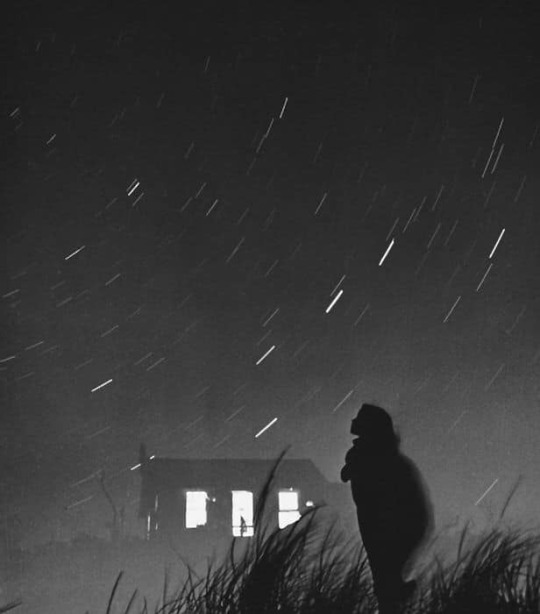
5 notes
·
View notes
Text
Smoke & Celluloid
Inglourious Basterds Pairing: Dieter Hellstrom / F!Reader Tags: Slow Burn, Enemies to Lovers Part 2/?

You heard the knock before the bell.
Three, sharp. Intentional.
You were already behind the counter when the door opened. Already composed. As if you hadn’t been waiting all morning, heart coiled like a spring.
Dieter Hellstrom stepped inside again, just as precise, just as unreadable. The leather of his gloves creaked faintly as he pulled them tighter. His black boots were perfectly polished to, his black leather coat made his silhouette sinister, his cap covered the keen gaze of his iced-blue eyes.
“Bonjour,” he said, voice low.
His eyes swept over the room like yesterday hadn’t ended.
You gave him the same look you’d practiced in the mirror — casual, alert, faintly puzzled. “Monsieur Hellstrom. Back so soon?”
He paused a fraction too long.
Then: “I said I’d return.”
You gestured toward the cinema, the register, the neat little space arranged like a dollhouse. “You’re welcome to inspect, as promised. Nothing’s changed since yesterday.”
He didn’t move.
Not right away.
“I disagree,” he said.
Your fingers froze over the edge of the desk.
He took a step forward.
“You seemed… different today.”
Your lips parted slightly — just slightly — but you closed them again. “Is that part of your inspection?”
There it was.
That flicker.
His jaw flexed once. His eyes narrowed like he was parsing a code buried beneath your words.
“You tell me,” he said, stepping closer.
You didn’t move. Wouldn’t give him the ground.
He stood on the other side of the ticket counter now, too close, his shadow stretching over the polished wood between you.
For a moment, neither of you spoke.
The only sound was the distant hum of the projector upstairs. Or maybe that was your blood in your ears.
His gaze dropped — not inappropriately, but appraising. Calculating.
“Do you live alone?” he asked suddenly.
A test.
“Yes,” you replied. No hesitation.
But the pause afterward was heavy.
You knew better than to fill it.
“Strange,” he murmured. “For a woman running a business. In these times.”
Another test.
You tilted your head slightly. “The French government supports independence, monsieur. Women must do what they can.”
That made his mouth twitch. Not a smile. Not amusement.
Something else.
“You speak like someone rehearsed.”
You allowed the smallest laugh, light and false like cheap champagne.
“Perhaps I’ve had practice.”
He leaned forward, just slightly.
“I think you’ve had plenty.”
Your breath caught.
Not fear. Not quite.
But a shift in the air. Like a storm crossing the edge of the horizon.
Dieter straightened again, brushing a hand across the counter as if dismissing the moment.
“I’ll check the booth,” he said flatly.
You nodded. “Of course.”
He walked past, and you felt the room realign with his movement — gravity following him like smoke.
But the moment between you still hung in the air like an unfinished sentence.
Dieter’s POV:
The booth was clean. Organized.
That, somehow, irritated him more than if it hadn’t been.
Everything in its place. Everything accounted for. Like her.
Still, he opened drawers. Ran fingers over the ledger. Flipped through the projection reels. Titles matched.
But none of it mattered.
He was already certain she was lying.
He just didn’t know about what.
And worse — far worse — was the gnawing heat beneath his ribs.
The way she looked at him. Not with fear. Not exactly. But with defiance pressed into stillness. Like a coiled wire.
She wasn’t like the others. She didn’t shrink. Didn’t charm. Didn’t plead.
She held.
She watched him like she was waiting for him to crack.
And something in him — something buried deep under medals and procedure — wanted to.
Not with violence. Not with suspicion.
With understanding.
That was the worst part. That part that wanted to see her undo.
But he couldn’t allow that. He wouldn’t. She was lying. That made her dangerous.
And yet…
He wasn’t leaving.
Not yet.
29 notes
·
View notes
Text
When i started youtube i did a survey of video essays to make sure like what i wanted to do wasn’t already being done.
And i looked at a bunch of black and queer video essayists in particular to see the field.
i did watch james somerton’s knock off Celluloid Closet video and i clocked it immediately like girl that’s everybody’s first intro to queer cinema. the doc was put up in 10 min chunks on youtube since 2006. they put the whole thing up on youtube the same year it lifted the 10min limit back in 2010. you not slick!
but every other queer film person on youtube does it too. they’d be nothing without Vito Russo. And they take from b ruby rich’s new queer cinema reader. that’s the scope of their understanding of queer film. And in the NQC reader there’s an essay on Queer Third Cinema which is just queer cinema of the Third World….which is a complete misunderstanding of Third Cinema. the NQC reader had its share of critics at the time of its publication. but they don’t know that.
And the black film people are hopelessly trying to reinvent Donald Bogle. every black video essayist has their own proprietary trope that is a manifestation of a tom, coon, mulatto, mammy, etc. There’s a reason bogle was, in a sense, generic because how these tropes continue to live change with the times but the core remains the same.
I’ve seen videos about the LA Rebellion as a movement from UCLA. I can’t remember if she said it in spirits of the rebellion or w/e but Julie has a line that goes something like “we weren’t a movement just a bunch of black kids at the same film school” and everybody hated UCLA. The LA Rebellion happened in spite of UCLA. Elyseo Taylor, who headed the program that we attribute to the LA rebellion —the ethnocommunications program— was fired after a year and the program shut down at the same time because the white failsons of producers weren’t getting the special funds the “blacks” were. And the LA Rebellion existed outside of UCLA too. The major actors of the movement studied or worked at The Performing Arts Society of LA (PASLA); Larry Clark taught cinematography there as well.
i know the hbomberguy video is about plagiarism but the other major issue with the youtube video essay industrial complex is that it’s giving “hey guys i’m taking media studies 101 and i just learned something that’s gonna blow your mind! It’s called the male gaze”
100 notes
·
View notes
Text

Recently I've been trying to remind myself to take in more "slow media" (akin to the "slow food" movement)- less content, more longform art. I've dusted off a very old list of films that I haven't seen but should, gleaned from the AFI Top 100. Some of it is patience-testing, from musicals (My Fair Lady) to epics (Lawrence of Arabia). Most of it is stuff that didn't necessarily appeal to me initially but is one of those Movies One Should Watch: From Here to Eternity or The Wild Bunch. And some of them are shameful, glaring gaps from the days before you could instantly stream gigabytes of data per second through a screen and into your faceholes. A film of the latter variety is The Third Man.
I watched it last night to keep from doomscrolling and doom-refreshing. (A strange and fascinating choice, in retrospect.) I had heard the above speech before, but in the context of the film it hits even harder. It's not exactly true —Germany invented the cuckoo clock, for one thing— but this speech, as well as others most of Orson Welles' film-defining dialogue, shows you just what kind of man Harry Lime is.
Like the protagonist, we're swayed by Harry's charisma even as we are repulsed by his words. By vastly oversimplifying a paradigm-shifting period in human history and adding a little rosy hindsight, what Harry's saying almost makes sense in a 'big picture' kind of way. But when you find out how Harry made his money and the human toll it took, the picture becomes much, much smaller. It's a great promise to think that hard times may make you into another DaVinci, but it is perhaps more likely that you'll simply be poor and die of the plague.
Relatable, right?
I guess what I'm saying is this: Watch a classic film. Really watch it. Even if that actor or director is "problematic". Put your phone away, even if you feel the urge to look up something that you think will clarify an aspect of what you're watching. Be discomforted. Ask what the film is trying to say. Read or watch The Celluloid Closet. Try to see what's between the lines. Buy physical copies of media you treasure. Put it in your memory where it can't be deleted from collective consciousness. So many classic films —Spartacus and High Noon, just to name a few— were allegories necessitated because of The Hays Code. And whatever censorship Project 2025 has coming down the pike means the great possibility that something like the Hays Code may exist again. Media literacy is going to be more important than ever. You will be forced to learn the differences between queerbaiting and queer coding, because coding might be the most queerness you get. Sometimes ancient Rome is just ancient Rome, and sometimes it's Hollywood under a combination of self-preserving, self-enforced guidelines and government witch hunting overseen by a petty tyrant.
We've seen this shit before.
#And quit saying shit like 'unalived' or 'r-worded'. Don't adopt the language of those whose livelihood depends on self-censoring#If you're not getting paid to talk then you have nothing to gain and everything to lose by saying the actual words#classic film#the celluloid closet
12 notes
·
View notes
Text

Review of Give My Regards to Broad Street, Nov. 6, 1984
All idealism aside, it's obvious that today's youth view the Beatles as a nostalgic phenomenon from a past era which somehow seems even more intangible since the death of John Lennon in 1980.
Bearing this in mind, one wonders what criteria should be used in reviewing Paul McCartney's Give My Regards to Broad Street. Should it be viewed as a production intended or the general movie going audience, or as one which caters primarily to the McCartney/Beatles fan movement? In all honesty, the film falls flat in the former category, while it soars in the latter and for that reason alone one should go the obvious route: the film is designed for a theoretic pre-sold audience (much like Star Trek or James Bond films) and as such should be judged in that manner.
It's been fourteen years since McCartney's last celluloid appearance (1970's Let it Be) and twenty since the Beatles classic, A Hard Day's Night, yet he has managed to effortlessly step in front of the camera again and exude the same charm and vibrancy which made him and the other Fabs (as in Fab Four, for those of you who missed out on it during the '60s) such a sensation at press conferences and on television appearances.
He has the ability to take his role very seriously, yet at the same time making the audience feel as though he's saying, 'why don't we have a bit of fun and music with me guitar?' It's that quality of Broad Street which allows it to succeed at the level it does.
There is a plot (albeit an extremely contrived one, which focuses on missing tapes for McCartney's new album, and the fact that if they're not recovered by midnight the star's empire will be handed over to an unscrupulous businessman with big ears and sun glasses. Egad!), what's an ex-Beatle to do? Why break into song, of course, and that's precisely the direction the film takes.
While the clock ticks away, the unflappable McCartney takes every opportunity to grab wife Linda, old buddy Ringo Starr, such rock star favorite as Dave Edmunds and Eric Steward, and perform (whether in the recording studio, on the set of a motion picture or in fantasy sequences) new versions of Beatles classics ("For No One," "Yesterday," "Eleanor Rigby,") McCartney solo hits ("Silly Love Songs," "Ballroom Dancing," So Bad,") and new numbers ("No More Lonely Nights," "No Values," "Not Such a Bad Boy").
The musical direction is quite effective, especially considering that it goes against the fast cutting trends of of such films as Flashdance or Footloose. The proceedings are handled smoothly, from the simplicity of McCartney strumming his guitar and cooing a Beatles medley to the elaborate futuristic backdrop of "Silly Love Songs." In fact the only musical sequence that falls flat is an instrumental called "Eleanor's Dream," which is a tedious exercise taking place in the 18th Century that is totally incongruous with the rest of the film.
While the supporting cast, ranging from Ringo to Sir Ralph Richardson (in his lead role) does its job, it's McCartney who's really on center stage at all times, and director Peter Webb manages to make his star shine throughout.
Give My Regards to Broad Street is a pleasant enough diversion to the movies, and, depending on how you regard McCartney and the Beatles, it will either give you cause to sing along, or wish they'd just "Let it Be."
--Ed Gross Jr.
Emphasis mine!
#give my regards to broad street#happy anniversary broad street#Paul McCartney#I love this review because it tries to judge the movie as it may have been intended#and the reviewer thinks it mostly works on that level but warns it's not going to be for everyone
13 notes
·
View notes
Text
Episode 4: The Sixteen Milliliter Shrine
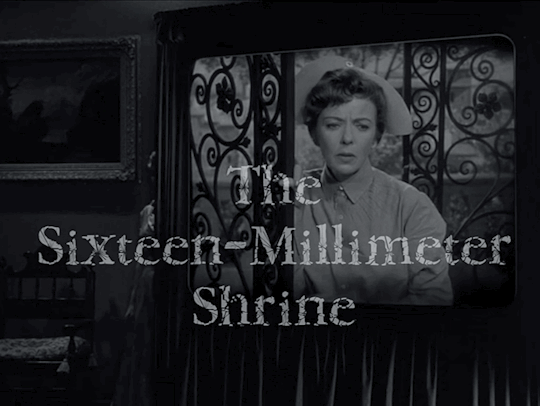
The Stranger
opening narration: Picture of a woman looking at a picture. Movie great of another time, once-brilliant star in a firmament no longer a part of the sky, eclipsed by the movement of earth and time. Barbara Jean Trenton, whose world is a projection room, whose dreams are made out of celluloid. Barbara Jean Trenton, struck down by hit-and-run years and lying on the unhappy pavement, trying desperately to get the license number of fleeting fame.
This episode centers on a Barbra Jean Trenton. She was big move star in her youth, but she has grown older and now spends every day in her theater room, watching her old movies and reminiscing. It has grown into an unhealthy obsession for her, and so her agent arranges for a part in an upcoming movie. When Barbra learns the role is a mother, she refuses, still living in the past. The director says giving this role to her would be a charity. After spending days in the theater room without coming out, her agent gets an old co-star whom she adored to visit, but she gets upset when she sees he has grown old and runs a supermarket chain. In the end, the maid finds Barbra not in her lounge chair but somehow inside of the film on screen. She was living so much in the past and now she never had to face the present.
This one was harder for me to place, I’d love to get other perspectives… I said the stranger because of how it manifests in theaters and performances. Also, the way the plot progressed and the ending. It seemed like something was very off, especially in the end, and the way she ends up in the screen feels uncanny and like it would fall in with the stranger.
#the twilight zone#twilight zone#rod serling#tma#the magnus archives#magnus pod#magnus archives#Ep 4
8 notes
·
View notes
Text
NFR Reviews #12: Newark Athlete
Released 1891 / Inducted 2010
Watch film here

Many early actuality films enticed viewers through increasingly varied imagery and notable people. Subjects of Thomas Edison’s film studio included a lineup of the era’s celebrities: boxers, dancers such as Carmencita, father of modern bodybuilding Eugen Sandow, and Buffalo Bill’s Wild West Show. Travelog films, sometimes funded by railways, shot footage of scenic locations across the US and into Mexico, Hawaii, Japan, China, and Hong Kong. Major news events such as reenactments of the Spanish-American war and the aftermath of the 1906 San Francisco earthquake were covered. There were even suggestive films of women for the appeal to horniness. But before all that, the National Film Registry’s oldest entry is comparatively ordinary: thirteen seconds of an athlete swinging clubs. Later films were oriented towards wide commercial appeal, but this one was an experiment with Edison’s new technology.
Edison’s role in the invention of motion pictures has often been overstated. Centuries of inventors experimented with displaying a series of images at such a rapid-fire pace it gave the illusion of movement. 17th century magic lanterns functioned similarly to a slide projector backlit by kerosene lamps, while 1830s Stroboscopes made drawings appear to move when viewed through slits in a disc. The advent of photography in the mid-19th century opened further possibilities: Coleman Sellers’ 1860s Kinematoscope, which mounted photos on a wheel of paddles. Eadweard Muybridge’s 1870s Zoopraxiscope, an image projector inspired by a bet on whether a running horse takes all four hooves off the ground (they do, and Muybridge proved it by setting several cameras along a racetrack and using a string to set them off in quick succession as the horse ran past). Etienne-Jules Marey’s 1880s Chronophotographs, taken at a rate of 12 pictures per second by a camera he developed to better capture subjects in motion. William Friese-Greene, who designed a camera and widely displayed his films but struggled with film projection. Louis Aimé Le Prince, a contemporary of Edison’s who created the earliest motion picture footage on paper negatives in 1888. Both he and Edison experimented with celluloid film, but Prince disappeared in 1890 before he could complete his experiments.
The earliest test films were the Monkeyshines trio from 1889-90, a failed attempt to film movies on cylinders similar to sound recordings of the time. Newark Athlete was a subsequent attempt at moviemaking with clearer image quality intended to be viewed on Edison’s Kinetoscope, a machine which was completed and previewed to audiences in 1891. A kinetoscope looks like a cabinet with an eyepiece mounted on top. After collecting a nickel from the viewer, the celluloid would pass between the lens and a lightbulb and roll by quickly enough to create a motion picture. While Edison received much of the credit, these inventions were primarily created by his staff, especially assistant William K. L. Dickson. Edison came up with the basic concept of a “kinetoscope” and provided employees with the pay and lab space, but Dickson was the one who designed and created the working machine. He and his team also invented the kinetograph, a camera which recorded the film through a mechanism that moved the celluloid quickly enough to produce exposures.
Technological progress comes about through a mix of direct collaboration, like the employees who worked on the Kinetoscope, and similar ideas between unconnected people building off one another, like how Edison was influenced by Muybridge and Marey. The reality of patent law encourages people to instead pretend that progress comes through singular geniuses far ahead of anyone else. Patents on successful inventions can impact the livelihoods of inventors, not to mention their pride and sense of accomplishment. The law is supposed to prevent people from outright stealing someone’s invention and taking all the profit. Towards the end of William Dickson’s life, he mused that recently he’d been getting more credit for “my pioneer work at Edison’s–in producing the 1st film/present day cinema film…” He dated film samples sent to a relative several years earlier than their actual year of creation. It was speculated as an attempt to increase his importance to the origin of movies, as well as to establish when ideas were created in the eyes of patent law. Edison’s attempts to profit off his patents were more aggressive and had wider implications to the early film industry. He tried to patent the concept of a movie camera in itself, forcing competitors out of business. The Motion Picture Patents Company, in which Edison agreed to share patents amongst the nine largest film companies, was intended to be a solution to this. In practice, it smothered up-and-coming independent studios in copyright lawsuits and gave Edison more power than before. In 1915, the Sherman Antitrust Act put a stop to this through a court ruling that patents cannot be used “as a weapon to disable a rival contestant, or to drive him from the field.”
In the environment Newark Athlete was created in, it makes economic sense for inventors to cling to their ideas as unique. But this attitude harmed the medium as a whole when taken too far through Edison’s monopolistic strategies. In addition to the works that come out of them, the secondary value of smaller studios is to provide more competition and thus persuade the big players to do better. In comparison to later actuality films which depicted notable parts of history and culture, Newark Athlete is a simple test of what the Kinetoscope was capable of. It doesn’t represent the clear beginning of film, but it doesn’t have to. The National Film Registry doesn’t include non-American titles, including the work of people like Marey or Prince, so starting here makes some sense. However, its simplicity and debt to predecessors don’t prevent it from being a major innovation in its time with continued historical significance.
Sources
https://www.moma.org/collection/terms/kinetoscope
https://www.pbs.org/wgbh/americanexperience/features/pickford-early-history-motion-pictures/
https://www.loc.gov/collections/edison-company-motion-pictures-and-sound-recordings/articles-and-essays/history-of-edison-motion-pictures/overview-of-the-edison-motion-pictures-by-genre/
https://blogs.unimelb.edu.au/librarycollections/2014/12/02/william-kennedy-laurie-dickson-a-legacy-of-the-moving-image/
https://www.lindahall.org/about/news/scientist-of-the-day/william-dickson/
https://www.saturdayeveningpost.com/2021/03/thomas-edison-the-unintentional-founder-of-hollywood/
https://www.bfi.org.uk/sight-and-sound/features/origins-cinema-early-inventors-pioneers
https://lkouniv.ac.in/site/writereaddata/siteContent/202004260643328777nishi_films.pdf
https://web.archive.org/web/20110514180127/http://www.kino.com/edison/d1.html
4 notes
·
View notes
Note
Hey random question : are you a film student ? (I kinda thought you are) and if you are and I’m not mistaken, in what ways do you enjoy a film? I mean are you hoping to work in the industry ? Also what kinda books do you study? (Sorry if I’m weird it’s just that I’m really curious about this stuff I like how you talk and my major is in stem which means no fun for a long while and since I like how you talk about art I just wanted to know what kinda stuff affected the way you think about stories/art/film)
this is a really nice message! not weird at all /genuine. my answer got long so it's under the cut >
i was also in stem but it wasnt for me! so i switched. im a double major in film studies + social science. i plan to continue down the social science route in my day career, but i hope to develop a career in the film industry on the side :-)
in the film industry, im interested in writing & older film, so it'd be cool to be able to work on the distribution-marketing of new editions of old films, or freelance essays/research. id also like distributing-marketing new releases (id looovve to use my graphic design skills in my job). but that's all up in the air and depends heavily on connections & chance! so ill work on it while having another stable job
ive been studying film full time for 2 years (fall 2023), but id started reading about it summer 2021 (4 yrs ago wow). each year, the more i read in and out of class, the more i realize how much more i need to read. im still so elementary. the classic writers are good. theyre classic for a reason! follow the discourse from there & follow your interests (go to any university library and search for essays about a film or topic or genre or movement or nation's cinema you like or are interested in ... read that then look-up what they cite. look around on tumblr & reddit on how to pir@te)
some very general classic film studies writers/books:
david borwell, kristin thompson, janet staiger (and their books: "film art" [an intro textbook], "film history: an introduction", "the classical hollywood cinema")
andrew sarris, andre bazin (essayists, sarris = key in auteur theory, bazin = realism in cinema)
sidney lumet (director) and his book "making movies"
i love pre-code hollywood cinema so i read a lot of: lea jacobs, richard maltby, thomas doherty
vito russo's "celluloid closet"
i always praise "shooting midnight cowboy" by glen frankel bc it made me understand the point of film history (the point is its all tied to industry, personal biography, political history, social history... a lot more)
thinking about it now, i just realized i subconsciously took quite a bit from frankel in my writing lol... these things happen without you knowing it. i hope this isnt too long or confusing! you can ask me any question you want. i love talking about film studies more than actual films
one last word: reading & understanding text like this is a skill. i still struggle. dont be scared to skim or skip or revisit. it's ok! it takes time
and thank you for the kind words
5 notes
·
View notes
Text
What is filmmaker video production?
What's Filmmaker Video product?
Introduction to Filmmaker Video Production
In the period of shrinking attention spans and soaring screen time, filmmaker videotape product stands as the ground between emotion and engagement. It’s further than just shooting footage; it’s about sculpturing a visual experience that resonates, informs, and persuades.
The elaboration of Visual liar
From the early days of celluloid rolls to moment’s high- description digital liar, videotape product has evolved into an intricate mix of art, technology, and strategy. What was formerly exclusive to cinema is now integral to marketing, education, and branding.
Defining the part of a Filmmaker
A filmmaker is not just a director. They’re visionaries, orchestrating a symphony of illustrations, sounds, and narratives. Their job is to convert abstract generalities into palpable illustrations that haul at heartstrings or enkindle minds.
Core Components of Filmmaker Video Production
Every compelling videotape is erected on a tripod of creativity, technology, and prosecution. These rudiments must work in harmony to produce a polished, important visual product.
Pre-Production The Blueprint Phase
Before the camera rolls, there’s a deep dive into creativity, planning, and logistics. This is the phase where pretensions are defined, coffers are gathered, and the vision starts to solidify.
Scripting The Heart of the Narrative
Words matter. A well- drafted script acts as the cadaverous structure of any videotape, guiding the tone, pacing, and communication. It transforms generalities into compelling narratives.
Storyboarding imaging the Concept
A storyboard is like a ridiculous strip for filmmakers are-visualization of the videotape. It helps brigades align creatively and spot implicit issues long before the shoot.
Casting and Crew Selection
gift selection is pivotal. Whether actors or presenters, the right faces and voices elevate the authenticity and relatability of the communication. Likewise, a professed crew ensures the vision is technically feasible.
The Magic of Cinematography
Cinematography is not just about pointing a camera. It’s about framing emotion, manipulating light, and orchestrating movement to breathe life into the story.
Sound Design and Its Subtle Power
Sound can amplify pressure, elicit nostalgia, or signal triumph. Music, medium noise, and dialogue are woven together to consolidate emotional engagement.
Post-Production Where the Story Comes Alive
This is the alchemical stage where raw footage is distilled into a narrative potion. Editors, colorists, and sound contrivers meet to polish the design to perfection.
Editing ways That transfigure Footage
From jump cuts to decelerate- stir goods, editing styles are precisely chosen to enhance liar. It’s an unnoticeable art that guides the bystander’s trip.
Color Grading for Emotional Impact
Colors elicit mood. A blue tinge can denote melancholy; golden tones frequently suggest warmth. Color grading subtly influences how observers perceive a scene.
The Rise of Digital Platforms and Distribution
moment’s vids are not just for television or cinema. With platforms like YouTube, Instagram, and OTT services, distribution is more dynamic and far- reaching than ever ahead.
Why Brands Are Turning to Filmmaker Video Production
In a cluttered request, liar is a brand’s stylish bet. A compelling film can elevate brand identity, connect with cult, and inspire action.
Part of a commercial film maker in Bangalore
A corporate film maker in Bangalore does not just make vids — they draft brand patrimonies. In India’s tech capital, they fuse invention with liar to produce high- impact commercial flicks that reflect organizational morality and objects.
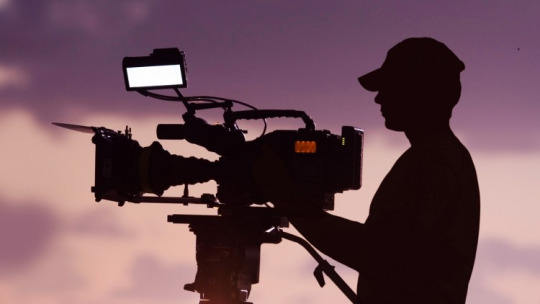
How video product companies in India are Leading Innovation
Video product companies in India are not just keeping up — they’re setting global marks. From using AI in editing to drone cinematography, they're instituting at every step of the product chain.
incorporating Creativity with Commerce Case Studies
From a fintech incipiency's viral explainer to a transnational’s CSR talkie, the convergence of art and commerce in videotape product is reconsidering marketing narratives.
Working with an internet marketing company in Bangalore for Maximum Reach
uniting with an internet marketing company in bangalore ensures that beautifully drafted vids do not just sit idle they reach the right eyeballs through SEO, PPC, social media, and influencer outreach.
Future Trends in Filmmaker Video Production
Interactive vids, AR integration, 360- degree liar — the future promises immersive and participative visual gests that blur the lines between bystander and creator.
Choosing the Right Video Production Partner
The right mate does not just understand cameras — they understand your brand. Look for a platoon that blends strategic sapience with creative brilliance and specialized prowess.
Conclusion The Art and Business of Filmmaking
Filmmaker videotape product is where imagination meets execution. It’s liar with purpose, imaged with passion, and powered by invention. Whether you are a brand, a incipiency, or a fibber, videotape remains your most potent supporter.
1 note
·
View note
Text
More than just a bull
You've probably heard the name of Ferdinand before, this charismatic bull has two animated films, one in 1938 and another in 2017, that quickly made people fall in love with him. But this charming story of a bull who preferred to smell flowers over fighting became much more than what it originally started as, from a children's book, to a banned story, to a tradition in Sweden. This is the story of Ferdinand, the Bull that changed the world.

The book of Ferdinand the bull (1936)
In 1936 the book "The story of Ferdinand" was released to the public. Written by Munro Leaf and illustrated by Robert Lawson, the story of Ferdinand was a fun short story of a bull who enjoyed smelling flowers over fighting who one day got confused to be an aggressive bull because of him getting sting by a bee, but when taken to the arena for a bullfight in Madrid, he just sat and smelled flowers and eventually returned home.
This book became very popular World wide specially in the United States because of the simple message it gave to kids about being yourself , an important message that will be important to the story (so put a pin on it while you read). The book ended up being a grate success, so naturally, Wald Disney jumped into the bag wagon and created their version of the story.

Ferdinand (1938)
On November 25th 1938, Disney would premier to the world the animated short of Ferdinand and to say it was a game changer is an understatement.
For starters we first hace to understand the way animation worked in the past. During the 30's the way animation worked was by drawing every frame by hand by the animators, each frame would be then recorded by a strip of film and checked to see the results in a machine called Moviola. Once Disney gave his approval the inking department would then draw every single frame again in a transparent celluloid sheet as well as being colored while the backgrounds is painted in water color, the frames are then shot one by one with a technicolor, a machine that would ran 3 strips of color film (red blue and yellow) at a time allowing them to combine into and create a fully colored film.
youtube
And what about the parts where the background is zoomed in or out? That's the job of the Multi plane camera. Have you ever seen how a pop up book has different cutouts at different heights depending on the scene? That's the same premise the multi camera used, by dividing backgrounds into different layers the camera could then shot the planes moving at different speeds creating the ilusion of depth. You can see this in the short in shots like Ferdinand at the end at the hill or when the arena is shown for the first time. All of this things combined resulted in this fabulous short that actually won Disney an award that same year, but Ferdinand's story is far from being over.
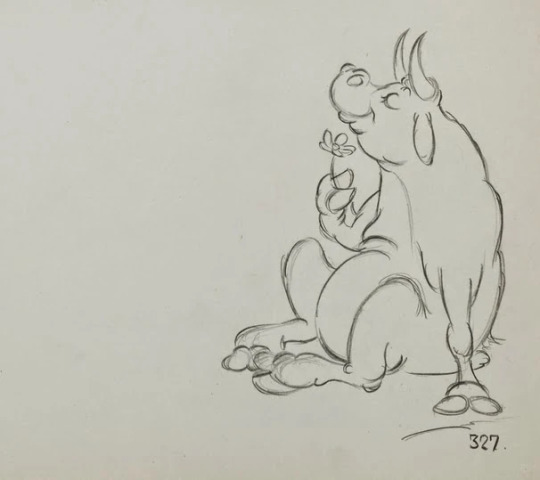
An Icon over the years
After the release of both the book and the film both of them ended up banned from Europe, this is because many of the political leaders at the time saw the film as pacifist propaganda so places like Germany, Italy, and ironically even Spain banned the screening of the short, in the words of Francisco Franco Bahamonde “Ferdinand es una maniobra judeomasónica a favor del pacifismo y de la República” (Ferdinand is a Judeo-Masonic scheme in favor of the republic and pacifism). Another group that Ferdinand impacted was the queer community and movement. Remember how I mentioned the story had the message of "Be yourself", well Disney's short took it one step forward and depicted Ferdinand with stereotypes or actions that would allow queer people to recognize as an allegory to them (this is also called queercoding) which is incredibly clear if you're part of the community like me just how easily the short can be taken as an allegory to both the community and how pathetic toxic masculinity can be.
For the people like me who were born in 2000's Ferdinand is also known as critique on animal cruelty and animal rights. While this is true, the mayor influence for this is neither the book or the original film but instead the 2017 movie produced by BlueSky studios, which re told the story of Ferdinand while also expanding on the previously discussed topics that the character was already known for.

Interestedly enough, in Sweden the original short film is also a staple tradition to watch it due to a show called "From All of Us to All of You" that is screened every Christmas eve where it contains a compilation of Disney shorts including Ferdinand, the short is actually so popular that the one year where they didn't screen it, the show reached it's lowest amount of views, with people complaining to bring Ferdinand back.
Happily Ever After
youtube
If you have the time I heavily recommend you to watch the original film. Personally this is a film that I saw as a child on a DVD and every time I re watch it the story of Ferdinand feels closer to home. So now next time you see this bull around, remember the incredible history he has both in his and our world. Until next time
5 notes
·
View notes
Text
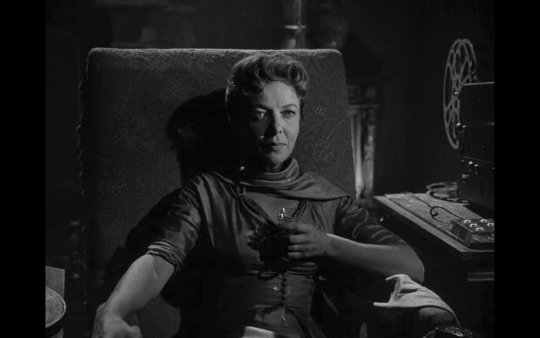
Rod Serling ֍ Ida Lupino in The Twilight Zone Season 1 Episode 4: The Sixteen-Millimeter Shrine (1959)
Picture of a woman looking at a picture. Movie great of another time, once-brilliant star in a firmament no longer a part of the sky, eclipsed by the movement of earth and time. Barbara Jean Trenton, whose world is a projection room, whose dreams are made out of celluloid. Barbara Jean Trenton, struck down by hit-and-run years and lying on the unhappy pavement, trying desperately to get the license number of fleeting fame.
. . .
To the wishes that come true, to the strange, mystic strength of the human animal, who can take a wishful dream and give it a dimension of its own. To Barbara Jean Trenton, movie queen of another era, who has changed the blank tomb of an empty projection screen into a private world. It can happen—in the Twilight Zone.
4 notes
·
View notes
Text
The Pink Phink (1964)
The Pink Phink (1964) directed by Fritz Freleng and Hawley Pratt, written by John W. Dunn. Part of “The Pink Panther” series.
youtube
"The Pink Phink" is a classic short animation film created in 1964 as part of the Pink Panther series. The plot revolves around a mischievous and creative character known as the Pink Panther, who decides to paint his house pink. However, a grumpy and artistic neighbour, a man named Big Nose, lives next door and is flabbergasted by the Pink Panther's rare choice of color.
The story unfolds as the Pink Panther and Big Nose engage in a humorous battle of wits and wills, with the Pink Panther continuously finding clever and funny ways to turn his house pink while Big Nose attempts to keep it blue. Ultimately, "The Pink Phink" is an iconic animation that explores the theme of creativity, individuality, and the importance of embracing uniqueness, all wrapped in a humorous and colourful tale.
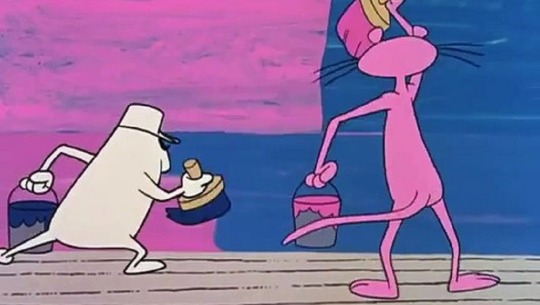
"The Pink Phink" was made using traditional hand-drawn animation techniques, which were the standard methods of animation production in the 1960s. Here's a brief explanation of the process:
The characters, such as the Pink Panther and Big Nose, would be designed, giving them their distinctive appearance and personalities.
Animators would then begin the labor-intensive process of creating the animation itself. Each frame of the animation is drawn by hand, with slight variations to create the illusion of movement. In the case of "The Pink Phink," this process involved countless drawings to bring the characters and scenes to life. After the frames are drawn, they would be inked to create clean lines, and then they'd be colored. In the case of "The Pink Phink," the choice of colours was essential to the storyline, as the Pink Panther repeatedly tries to change the color of his house from blue to pink. The inked and coloured drawings are transferred onto transparent celluloid sheets, or "cells." These cells can be layered over the background art, allowing the characters to move against the painted backgrounds.
The cells and background art are photographed one frame at a time using a special animation camera. This process captures the individual frames and assembles them into a complete film. And last but not least, the final step involves adding sound effects and music to enhance the viewing experience.
"The Pink Phink" and other animated shorts of its time were typically shown in theaters before feature films, forming a part of the movie-going experience. This was the era of theatrical cartoons, and animated shorts were a common prelude to the main feature.
Audiences in the 1960s generally had a positive reaction to animated shorts like "The Pink Phink." These cartoons were a beloved form of entertainment for both children and adults.
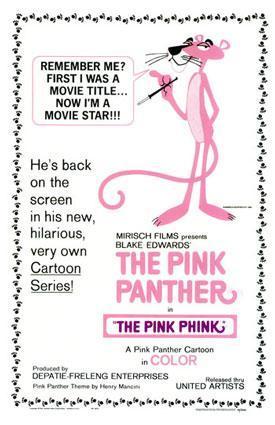
https://en.wikipedia.org/wiki/The_Pink_Phink
https://www.imdb.com/title/tt0058472/?ref_=ttls_li_tt
https://tvtropes.org/pmwiki/pmwiki.php/WesternAnimation/ThePinkPhink
3 notes
·
View notes
Text
The Enduring Allure of Antique Mont Blanc Pens
Antique Mont Blanc pens represent a legacy of craftsmanship, luxury, and cultural prestige. Revered not just as writing instruments but as works of art, these pens have become cherished by collectors, historians, and writers alike. Their historical significance, unparalleled construction, and elegant design make them stand out in the world of fine antiques. To understand the true value of antique Mont Blanc pens, one must appreciate the intricate blend of functionality and aesthetics that defines them.
The History Behind Antique Mont Blanc Pens
The origins of Mont Blanc pens trace back to the early 20th century, a time when fountain pens were not just tools but status symbols. These pens were meticulously handcrafted, often taking months to complete, with attention to detail that mirrored the precision of watchmakers. The term “antique” typically refers to Mont Blanc models produced before the mid-20th century, especially those from the 1920s through the 1950s. These early pens mark the evolution of Mont Blanc from a regional brand into an international icon.
Early designs included features like safety fillers, ebonite barrels, and intricate gold or palladium nibs. The use of celluloid and later resin reflected advancements in material science, while the evolving designs symbolized the cultural aesthetics of their respective eras. These pens often incorporated design elements reflective of Art Deco or Bauhaus movements, providing more than just writing comfort—they reflected the era's artistic voice.
Why Antique Mont Blanc Pens Are Highly Coveted
Antique Mont Blanc pens carry significant value for several reasons, with craftsmanship and heritage ranking highest. Each pen was assembled by hand, often by master artisans who passed down their skills through generations. The result was a pen that not only functioned with flawless smoothness but also featured unique stylistic nuances—no two were exactly alike.
The nibs of antique Mont Blanc pens are often crafted from 14K or 18K gold, and they develop a writing “personality” over time, molding slightly to the user’s hand. This responsiveness is something modern mass-produced pens struggle to emulate. Furthermore, these antique pens are known for their balance and weight, designed to enhance the natural rhythm of handwriting.
In addition, the design cues—engraved logos, mother-of-pearl inlays, classic black-and-gold combinations, or rare color editions—make antique Mont Blanc pens highly desirable. These features elevate them from mere utility objects to symbols of style and class.
Types and Models That Stand Out
Among the many models of antique Mont Blanc pens, some stand out for their rarity and historical value. Early “Rouge et Noir” safety pens from the 1910s, for instance, are among the most collectible. With retractable nib mechanisms and hard rubber construction, these pens represent the foundation of Mont Blanc’s pen innovation.
The “Meisterstück” (or “Masterpiece”) line, first introduced in 1924, is another cornerstone. These pens, particularly the earlier models with serial-free caps or long-tined nibs, remain some of the most pursued antiques in the pen world. The design has evolved over time, but the early editions exude a character and elegance that captivate both seasoned collectors and new enthusiasts.
There are also piston fillers from the 1930s and 1940s, which introduced advancements in ink capacity and flow. These models often featured transparent ink windows, a detail that combined function with design ingenuity. Over time, limited editions and commemorative releases also became part of Mont Blanc’s strategy, and some early versions of these now qualify as antiques themselves.
Materials and Manufacturing Excellence
One of the defining traits of antique Mont Blanc pens is their exceptional use of materials. Many early pens utilized hard rubber (ebonite), which was later replaced by celluloid and then by precious resin. Hard rubber offered durability and a warm feel, though it required more care. Celluloid brought vibrant colors and patterns that are now highly prized due to their rarity and the difficulty of working with the material.
The nibs, typically made from high-karat gold, were often semi-flexible, meaning they could produce varying line widths depending on pressure—ideal for calligraphers and expressive writers. Feed systems were engineered to allow consistent ink flow, and most older models feature a well-balanced grip, making long writing sessions enjoyable.
These pens were not only built to last; they were built to be heirlooms. Their durability today is a testament to the masterful engineering that went into each piece. Many collectors delight in restoring these pens, bringing them back to working condition with original parts or expert repairs.
The Collector's World: Value and Rarity
Antique Mont Blanc pens are central pieces in many high-end writing instrument collections. Their value is driven by rarity, condition, age, and provenance. Original boxes, papers, and documentation increase their appeal significantly, but even without them, well-maintained pens can command impressive figures.
Collectors often look for unique features like rare nib types, unusual colorways, or specific engravings. A pristine example from the 1920s with a flexible nib and original ebonite body might fetch thousands of dollars, while limited-run editions with historical significance can surpass even those prices.
Beyond monetary value, many collectors find deep personal satisfaction in owning a tangible piece of history. These pens tell stories—of business deals, love letters, personal journals, and world-changing speeches. Holding one is like holding a thread that connects generations of thinkers, writers, and creators.
Caring for Antique Mont Blanc Pens
Proper care is essential for preserving antique Mont Blanc pens. These instruments are not only old but often made from materials that require specific handling. Hard rubber can discolor if exposed to sunlight, and celluloid can be sensitive to temperature changes.
Cleaning the nib and feed regularly with water—never harsh chemicals—is crucial. When storing antique pens, keep them in a temperature-controlled environment, preferably upright to avoid ink leakage. It’s also wise to write with them periodically, as it keeps the ink flow system in working order.
Servicing by a specialist can prolong the pen’s lifespan. Experts can replace deteriorating sacs, recondition nibs, or even reapply faded logos. While modern pens can often be self-maintained, antique pieces are better left in professional hands for more complex repairs or restorations.
Cultural Significance and Legacy
Antique Mont Blanc pens are more than just collectibles; they are cultural icons. They have appeared in films, literature, and the hands of influential figures across politics, arts, and science. They have signed treaties, marked beginnings of companies, and penned the most intimate thoughts in personal diaries.
They represent a period in history when writing was more than communication—it was an experience. The deliberate act of uncapping a fine pen, dipping it into ink, and letting thoughts flow across the page carried ritualistic importance. In a world that increasingly favors speed over substance, antique Mont Blanc pens are a nod to timeless quality and reflection.
Conclusion: The Timeless Appeal of Antique Mont Blanc Pens
Antique Mont Blanc pens stand at the intersection of functionality, artistry, and history. They embody a lost era of elegance, where craftsmanship reigned supreme, and every detail mattered. Whether you're a collector, a calligraphy enthusiast, or someone who simply appreciates fine objects, the allure of antique Mont Blanc pens is hard to resist.
Their continued relevance in a digital age underscores a universal truth: quality never goes out of style. Holding one of these pens isn’t just about writing—it’s about connecting with the past, appreciating the present, and investing in a legacy that will inspire generations to come.
1 note
·
View note
Text
Blog 1 - Animation - the postmodernist visual medium

Though Live action film and animation both have the same foundations, the evolution of cinema theory and the insistence on the indexical quality of cinema and as well as the celluloid had caused them to become estranged to a point where animation is even wrongfully considered a genre of cinema, instead of a medium.
Early film theorists such as Andre Bazin argued that it was cinema’s ability to preserve and represent reality that was at the core of what made cinema an art form, “The cinema is objectivity in time.” (Bazin, 1967). the physical aspect of cinema was important.
However with the advent of digital media, such definitions are challenged. As live action material is combined with visual effects and animation, where the footage is manipulated frame by frame, the representation of reality is no longer the prime focus and now cinema can no longer be clearly distinguished from animation (Lev Manovich, 1995).
So it becomes necessary to expand on the qualities of cinema as a hybrid artform, one that combines narrative, composition of the frame, manipulation of time and space, music, performance and dialogue to fully realize the potential of cinema as a medium. (Noël Carroll, 1985). In the rapidly changing technological market such an expansion is almost necessary.
Another important aspect to consider is Cinema's ability to represent movement, it is in capturing movement in time that cinema is able to set it self apart from other works of art, by doing so the "spirit" of cinema would be achieved. (Irzykowski, 1977).
Considering these broad definitions of the inherent qualities of cinema as well as the changes brought to it by the advent of digital media, Animation has becomes once again a dominant medium of cinematic storytelling. (Lev Manovich, 1995).
Now i will analyze a small sequence from the animated movie Kung fu Panda 2 to highlight how an animation movie has been able to combine the different strengths of the cinematic medium to create an impactful sequence.
youtube
While animation is generally used as an umbrella term, it is made up of many different techniques. the two most popular being 2D hand drawn animation and computer generated 3D animation.
3D animation comes with the capacity to make incredibly detailed and lifelike images promoting a sense of realism, whereas 2D animation gives more room for exaggeration and a more abstract aesthetic.
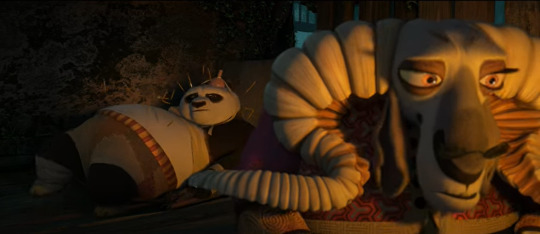

This difference in mediums is used excellently to bring home to the viewers the difference between reality and memory of the character. The inherent potential for realism in 3D is contrasted with the abstractness and heightened reality of 2D. It also helps convey the separateness and deniability that the character has associated with the memory by keeping it two different mediums.
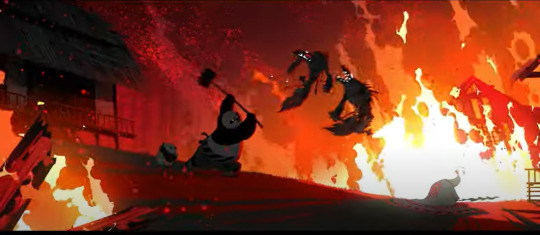
Bright warm and contrasting colors are used effectively in the 2D sequence to not just convey the intensity of the memory and danger that the characters in it are under but the nightmarish aspect the main character associates with it as well.
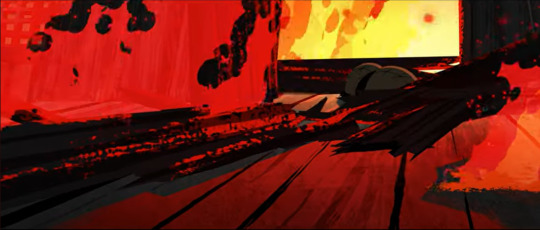
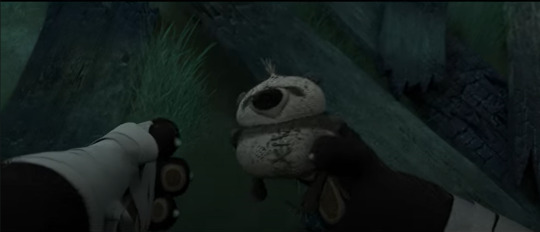
As the scene progresses and the lines between both memory and reality begin to blur, objects from the memory get converted into 3d objects, emphasizing the fact that the memory is not just a nightmare that the character has but rather a very real incident from his past. It also is a visual representation of the acceptance the character is experiencing of his past, which had kept him away from achieving "inner peace".


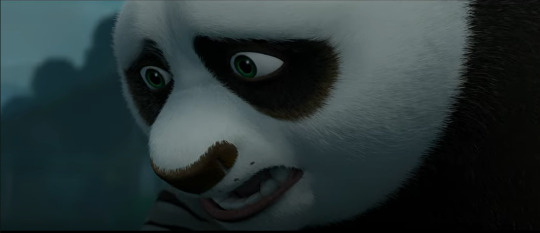
This visual metaphor comes to a conclusion as the 2D memory is suddenly replaced with a realistic 3D animation, signifying the characters acceptance of his past and the realness of the memory. However, the colors in the memory are still warm with a soft glow around the characters, which could be to signify not just the heat in the forest but the warmth of a mothers love.
This is an excellent example of using two different types of animation to not just create a visually stunning sequence but one that is paramount to the narrative and the development of the character.
It also takes advantage of the temporal properties of cinema, the back and forth edit between the past and the present helps not only the audience figure out the narrative faster but also puts us into the mind of the character. Time is almost faster in the sequences that are his dreams to heighten the danger and desperation in the situation which also helping us feel the characters own panic. It is slowed down when the character begins to find peace in himself. The sequence also ends with a montage which charts his whole journey in the first film that supplements and brings home the point of the dialogue that precedes it.
Movement is also emphasized to show the character finally achieving peace in himself while also using it as a clever way of transitioning between reality and the memory.
The sequence is also elevated by the choices the dialogue used and the music which reaches its crescendo as the character goes through his transformation. Dialogue is used only give the slightest of exposition and an interplay of both dialogue and visual storytelling is used to let the audience understand the whole narrative. A prime example of the "show, don't tell" rule.
While this was a small sequence in a movie, i felt like this was a really good example of what animation means to digital cinema and how easily it integrates and elevates its aspects to tell a memorable narrative, making the case for animation to be the post modernist medium for visual storytelling.
Citations:
Bazin, A. and Gray, H., 2005. What Is Cinema? Volume I. 1st ed. Berkeley: University of California Press. Available at: http://www.jstor.org/stable/10.1525/j.ctt5hjhmc
Manovich, L., 2001. What is digital cinema? In: N. Mirzoeff, ed., The Visual Culture Reader. 2nd ed. London: Routledge, pp. 285-298.
Gehman, C. and Reinke, S., 2005. The sharpest point: Animation at the end of cinema. Toronto: YYZ Books.
Carroll, N., 1985. The specificity of media in the arts. Journal of Aesthetic Education, 19(4), pp.5–20. https://doi.org/10.2307/3332295
Kuc, K., 2016. Karol Irzykowski and Feliks Kuczkowski: (Theory of) Animation as the cinema of pure movement. Animation, 11(3), pp.284–296. https://doi.org/10.1177/1746847716660685
Manovich, L., 2001. The language of new media. MIT Press.
The Unusual Shen Fan, 2023. [Kung fu panda 2 - Po finds the truth 4k]. [YouTube video] Available at: https://www.youtube.com/watch?v=ANmNtzyVyaY&ab_channel=TheUnusualShenFan
Hushain, J., Gupta, V. & Sharma, M., 2023. An analysis of the various kinds of animation. Vol. 10, pp. 160–166.
0 notes
Text
WEEK 2
WHAT IS A SHORT FILM ?
to start with, what is a film ? film is a dynamic, visual language that captures and conveys the complexities of human experience, emotion, and imagination. It is a medium where light, movement, sound, and narrative converge to craft immersive worlds and provoke thought. Through the lens of a filmmaker, the frame becomes a canvas, and the sequence of images, a visual poem, capturing the ebb and flow of time, space, and feeling.
At its core, a film is composed of a sequence of images, usually captured on film stock or digitally, that are projected at a rapid speed (typically 24 frames per second) to create the illusion of motion. These images are often accompanied by sound, such as dialogue, music, or sound effects, to enhance the storytelling experience.
Short films are often used by filmmakers to showcase their skills, experiment with storytelling techniques, or express creative ideas in a more concise format. They are commonly shown at film festivals, online platforms, or as part of special screenings.
A film is a medium for recording, producing, and displaying moving images and sounds, typically used for storytelling, artistic expression, or communication. It is also known as a motion picture or movie. Films can be made in a variety of genres, including drama, comedy, documentary, action, horror, science fiction, and animation, among others.
At its core, a film is composed of a sequence of images, usually captured on film stock or digitally, that are projected at a rapid speed (typically 24 frames per second) to create the illusion of motion. These images are often accompanied by sound, such as dialogue, music, or sound effects, to enhance the storytelling experience.
A film can serve many purposes:
Entertainment: Many films are made for entertainment, drawing audiences to theaters or home screens.
Art: Film is also considered an art form, with directors, writers, actors, and other artists contributing to the creation of a cinematic experience.
Communication: Films can convey messages, raise awareness on social issues, or provoke thought.
Education: Documentaries and instructional films are used to inform or teach about various topics.
Films are typically distributed in theaters, on television, streaming platforms, or through physical media like DVDs and Blu-rays. The term "film" originally referred to the physical celluloid strips used to capture images, but today, it is often used to describe both analog and digital formats.
there are usually 3 types of films
0 notes
Text
#1153 Was the transition from silent movies to talkies difficult?


Was the transition from silent movies to talkies difficult? Yes, the transition from silent movies to talkies was difficult, not just technologically, but also for the actors. Movies began to appear alongside the invention of photography. Early photographs took hours to take, but once it became possible to take photographs instantly, movies were the next logical step. After all, a movie is only a lot of photographs taken very quickly one after the other. Movies rapidly became popular, and movie theaters sprang up in most towns. Movies were short and movie companies tried to make as many movies as they could. People would pay to go to the movie theater and watch more than one movie. A lot of these silent film stars became household names. Some of them most people would still know, but not a lot. A lot of silent films haven’t stood the test of time either, primarily because they were filmed on celluloid, which is highly flammable. Incidentally, silent movies were not called “silent movies” until talking pictures took off because they were just movies. Giving a name to something after the fact is called a retronym. By the 1920s, movies with sound had become technically possible. Ernst Ruhmer had come up with a way to record sound the sound onto a film by translating the sound into light. The first real talking movies were released in 1927 and the last silent movie was “The Poor Millionaire” released in 1930, but once talkies had appeared, there was no real hope for silent movies. Charlie Chaplain made two silent movies in the 1930s, but they were only released because of his star power. The studios had stopped making them. So, was the transition from silent movies to talkies difficult? There were several difficulties that arose. The first were technical. Recording sound onto the film was not easy because the quality of mics and sound recording devices was low. Mics had to be set in specific places and the actors needed to stand very still underneath them and direct their voices at the mic or the mic wouldn’t pick. It couldn’t record sounds that were too loud, too quiet, too high, or too low. They had a lot of trouble recording women’s voices. The mic would also pick up all of the other noise in the studio, so everything needed to be kept soundproof. Cameras at the time worked by rotating the film through the camera as each frame was shot, which was a very noisy process. The cameras needed to be sealed up in soundproof booths as well. Managing to pick up all of the sound was a very taxing job. Replaying the sound in the movie theater was not easy as well. As all movies were silent at the time, no movie theater was wired for sound. They slowly transitioned, but it was not an easy process. In the beginning, it was difficult to amplify the sound, making it hard to hear. Even when movie theaters were wired for sound, the sound and the picture weren’t always in sync. The technical problems were overcome fairly quickly, as is the way with most new technology. The effects for the actors were longer lasting and sometimes career ending. The first problem was the style of acting. Silent movie stars had to express everything with their body language and their facial expression. They had exaggerated movements and the scenes were shot in a way that made them as easy to understand as possible. When sound came along, these actors had to recite their lines, but they were too used to over exaggerating. Talkies required a different type of acting skill. A lot of the new actors that became big in the talkies had come up from theater or musicals, where they were used to talking as a part of acting. A second problem was that some silent movie actors didn’t have voices that matched the characters that had become famous for portraying. Their voice, or what they were saying, could ruin the image and then the studios didn’t want to use them. A heavy foreign accent was no problem in a silent movie but many actors lost their jobs because of it when talkies came about. The directors and the screenwriters also had to adapt. This who new way of acting required new scripts and new methods of directing, but that didn’t come easily. Scripts were unnatural, poorly paced, and far too stilted. It took a while for the directors to get the hang of the new style. However, just as with the technology, there were a lot of problems, but it didn’t take too many years to overcome them. By the early 1930s, the quality of talkies was rising and a whole new raft of stars became famous. Some silent stars that did manage to make the transition that we will have heard of were Greta Garbo, Joan Crawford, and Lauren and Hardy. And this is what I learned today. Enjoyed this? Try these: - #673 When did silent movies end? - #777 What are “Spaghetti Westerns”? - #189 Why does our voice change when we inhale helium? - #594 Why do we lose our voice when we are sick? - #606 Why do cameras have mirrors? Sources https://www.reddit.com/r/AskHistorians/comments/108qt35/why_was_it_so_hard_for_so_many_actors_to_make_the/ https://collider.com/babylon-true-story https://www.centralcasting.com/how-talkies-changed-the-film-industry https://ilearnedthistoday.com/index.php/2023/08/07/when-did-silent-movies-end/ https://www.backstage.com/magazine/article/silent-film-actors-transitioned-talkies-6882 https://en.wikipedia.org/wiki/Silent_film https://www.reddit.com/r/TrueFilm/comments/75z49j/chaplin_and_the_emergence_of_talkies/ Image By Metro Pictures Corporation (still) - File:Sheet_music_cover_-_JULIO_-_OF_THE_ARGENTINA_(1921).jpg, Public Domain, https://commons.wikimedia.org/w/index.php?curid=45462406 Read the full article
0 notes